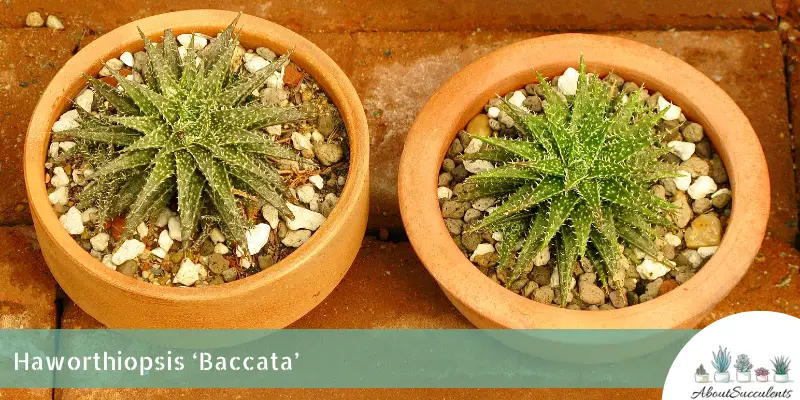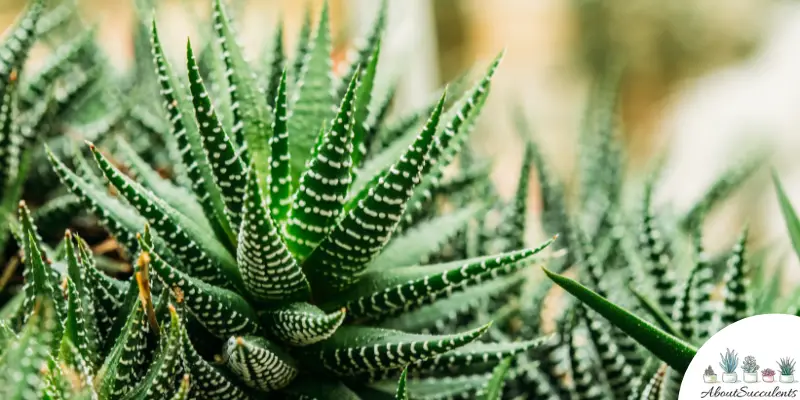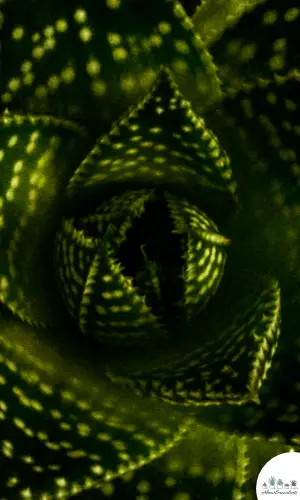
Haworthiopsis “Baccata” is a succulent that captivates onlookers with its dark-green colored, triangular leaves that are distinguished by their white, pearl-like bumps.
The leaves measure 1.57-inches to 2.32-inches (4cm to 6cm) long with tips that curve inward and form a tight rosette that grows upright. When given more exposure to the sun, the leaves change color from dark green to reddish-brown.
Baccata is a short succulent and can reach a maximum height of 5-inches (13cm) with a width of 5-inches (13cm). Properly cared for, Baccata will produce offsets that cluster on the base.
From spring to summer, Haworthiopsis Baccata will bloom white, tubular-shaped flowers. This slow-growing succulent originates from South Africa and belongs to the Aloaceae family.
General Information
Also known as:
Plant Family: Aloaceae
Origin: South Africa
Height: 5-inches (13cm)
Exposure: Partial to full sun for up to 6 hours per day; direct sunlight will change the color of the leaves from dark green to reddish-brown.
Water Needs: Follow the “Soak and Dry” method; only water the soil when it’s 100% dry.
Soil Type: Succulent soil with added gritty materials like coarse sand, perlite, and pumice.
Soil pH: 6.5 to 7.5
How to Grow and Care for Haworthiopsis “Baccata”

Haworthiopsis Baccata is an excellent succulent for first-time hobbyists because it’s a no-frills plant that won’t be a hassle to grow and care for.
For starters, it thrives under low-light conditions which makes Baccata an ideal indoor succulent. This is good news for those who live in regions where the temperature can turn frosty and drop below 30° F (-1.1° C).
Baccata isn’t a cold-hardy plant and should be grown in a pot when the weather is freezing.
Sunlight
As an outdoor plant, position Haworthiopsis Baccata in a place where it can get up to 6 hours of partial to full sunlight every day.
Indoors, place Baccata near a window that gets partial sunlight. If lighting is a challenge, buy a Grow Light.
It’s important for Haworthiopsis Baccata to get sunlight on a daily basis otherwise the succulent will undergo etiolation. This is a condition whereby the leaves stretch out as if they’re looking for sunlight. If etiolation isn’t addressed, the leaves will thin out, wither, and die.
Watering

Haworthiopsis Baccata is a succulent that can survive long periods without water. Don’t worry if you forgot to water Baccata during your 2-week vacation on a faraway island. When you come home, Baccata will remain healthy and beautiful.
With succulents, neglect is best when it comes to watering. Giving the plant too much water will be hazardous to its health because the roots will be immersed in a moist environment for a long time and start rotting.
To water Baccata, follow the “Soak and Dry” method which means you only water the soil whenever it has completely dried out. And when you do water the soil, you must give it a thorough soaking.
In the summertime, it might take seven to 10 days between waterings. In contrast, the soil might only need water once a month during the winter months.
To test the soil for dryness, simply insert a stick an inch deep. And if the end of the stick feels dry to the touch after you pull it out, Baccata’s soil is ready to get a good soaking.
Pot and Soil
If you just bought Haworthiopsis Baccata and it’s housed inside a charming glass container, the first thing you should do is to buy either an unglazed ceramic or terracotta pot and transfer the succulent to the new pot.
A pot made of glass will not support soil aeration and evaporation thus maintaining moisture for a longer period of time. In comparison, unglazed ceramic and terracotta are materials that support aeration and allow moisture to escape from the soil quickly.
Choose a pot that’s slightly larger than the base of Baccata to enable the roots to grow without getting entangled. Lastly, make sure the pot has a drain hole at the bottom to filter out excess water. You know that it’s time to stop watering the soil when water starts trickling out of the drain hole.
Baccata grows best in gritty soil. You can plant the Haworthiopsis in a commercial succulent mix then just add 50% to 70% gritty materials like perlite, pumice, and coarse sand to speed up soil drainage.
How to Propagate Haworthiopsis Baccata
Propagating Haworthiopsis Baccata is easy because itt grows offsets that you can pull out and use to grow more of this lovely succulent.
Offsets Method
Step 1: Use a sterilized and sharpened knife to free up the offsets that are growing at the base of the plant.
Step 2: Gently pull out the offsets from the soil.
Step 3: Allow the offsets 2 to 4 days to develop hard calluses.
Step 4: When the offsets are ready, plant them in well-draining succulent soil.
Step 5: Lightly water the soil and place the container near a window that gets 6 hours of partial sunlight every day.
Step 6: If the roots have developed, only water the soil when it has dried out completely.
Frequently Asked Questions
Is Haworthiopsis Baccata Toxic To Cats and Dogs?
Haworthiopsis Baccata isn’t included in the list of plants toxic to cats and dogs that appear on the website of the American Society for the Prevention of Cruelty to Animals (ASPCA).
Why Is My Haworthiopsis Baccata Dying?
Haworthiopsis Baccata is a durable succulent that needs very little care. However, overwatering will lead to its death. Also, if you don’t remove the pests that have made Baccata’s leaves their home, your succulent will get weak and eventually die.
While you don’t have to fuss over Baccata, you should check up on it once in a while and look for signs of weakness or infection.
Overwatering
Water breeds life and fungi are a form of life. If the soil is kept moist for too long, it will breed fungi. And if the roots rupture, the fungi will find their way inside the succulent.
You’ll this is the situation with Baccata the moment you notice the appearance of yellowish-blackish spots on its leaves or if they become mushy. Don’t wait any longer and cut these infected sections immediately with a sterilized and sharpened knife. Otherwise, the infection will spread.
Once you’ve removed all of the infected sections, sterilize the knife with 70% isopropyl alcohol and focus on the roots. Remove the plant from the soil and cut off all of the roots that have rotted away.
Let Baccata dry out while you begin preparing a new pot with a fresh batch of succulent soil with added gritty materials. Plant Baccata in its new home but wait for 2-3 days before watering the soil.
Pest Infestation
Like all succulent plants, Haworthiopsis Baccata attracts mealybugs, aphids, and scale insects. These pests will help themselves to the sap found in the leaves of Baccata.
Without the sap, your plant will grow weak from a lack of nutrients. The pests will also leave by-products that can contaminate Baccata. These appear as white, cotton-like substances on the leaves.
To remove pests, spray the succulent with diluted neem oil and wipe the leaves with a cotton ball soaked in 70% isopropyl alcohol.
Yes, from spring to summer Haworthopsis Baccata will produce small, white-colored, and tubular flowers.
Last Updated on June 9, 2022 by Sofia Lara